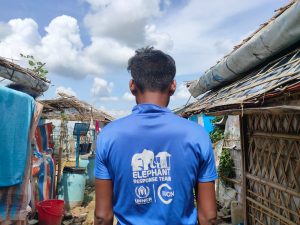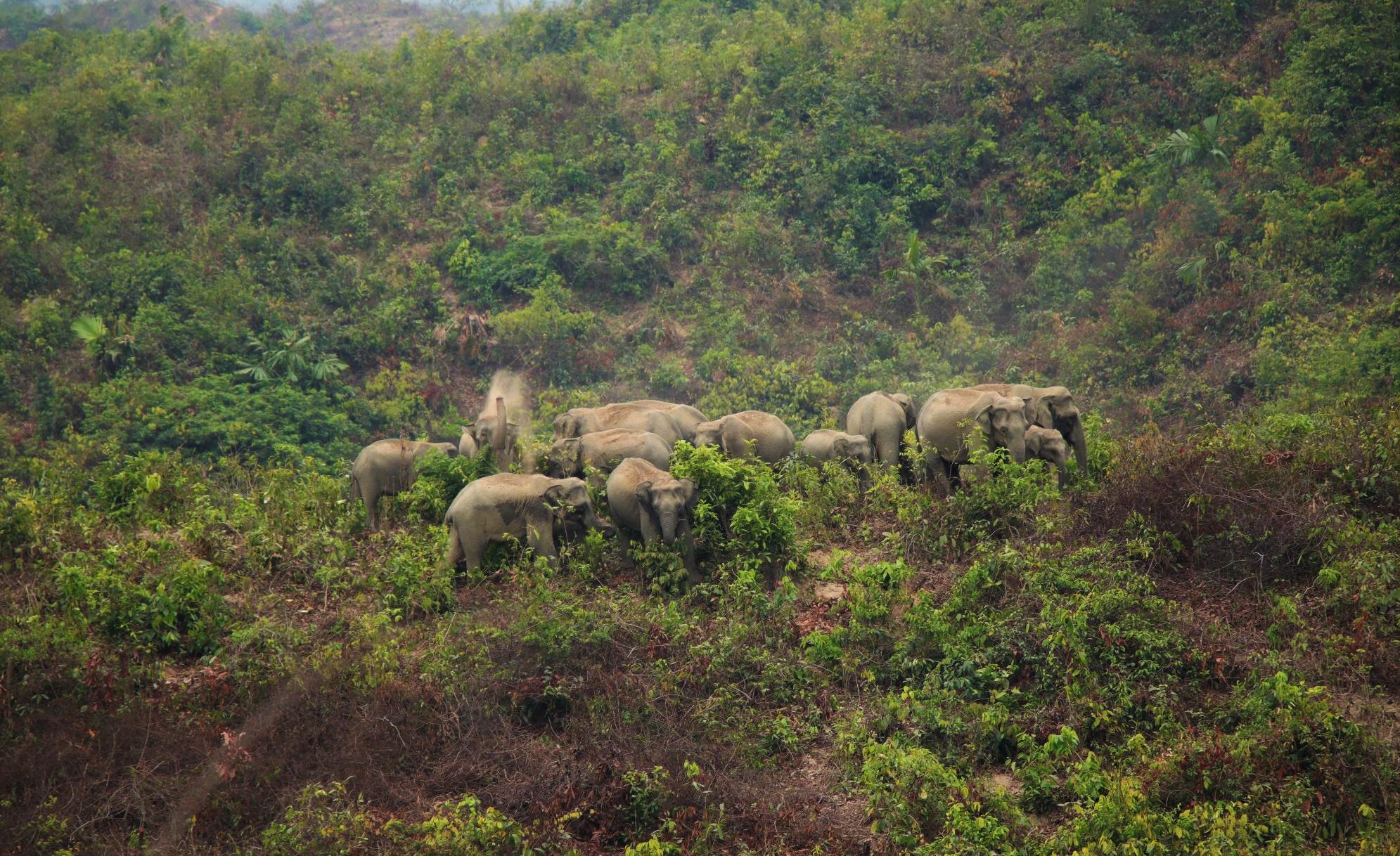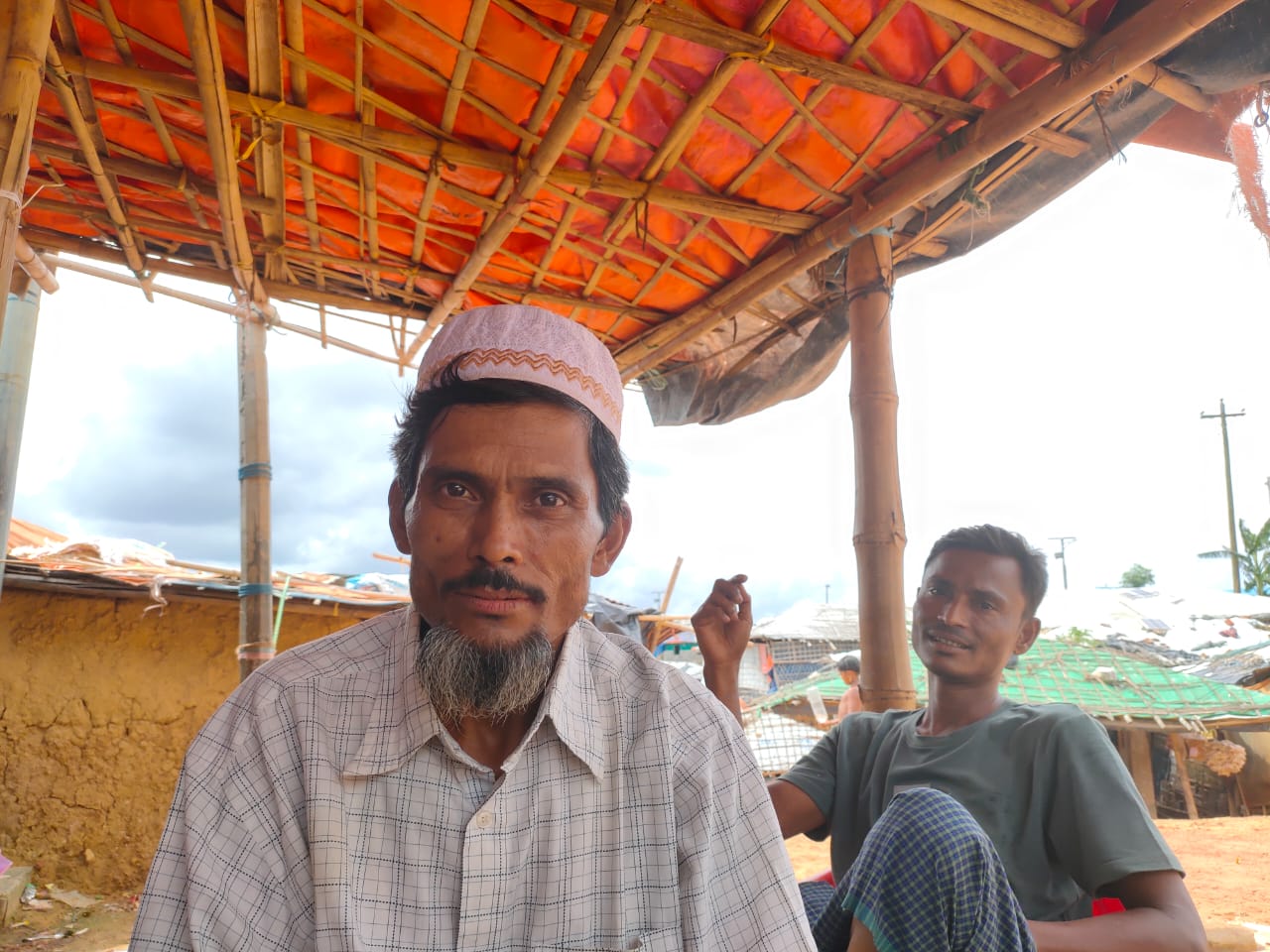On August 19, 2017, at around 1 a.m. when everyone was asleep, an elephant ventured into camp 6 of Kutapalong Refugee Camp, damaging shelters and wreaking havoc. Everyone was able to escape except 75-year-old Amin Shorif, who was trampled to death by the elephant. This is not an isolated incident. Up until 2019, 14 people from the Rohingya refugee camps in Bangladesh have been killed by sporadic elephant incursions.
Recently, however, there have been no deaths caused by the elephants and that is attributable to the fact that an Elephant Response Team, set up by the UN refugee agency, UNHCR, has been operating in the camps. The volunteers of the team get hands-on training from professionals so that they are well equipped to handle an emergency.
There is an elephant watch tower in each camp. The volunteers keep in touch with the watchmen stationed at the towers. When the team members spot an elephant, they gather in one place and try to drive it away by surrounding it. They use torches, microphones, loudspeakers, and whistles so that the elephant doesn’t charge at them. They keep one way open for the elephant to go out. At the same time, they alert the people using loudspeakers and whistles, so others know not to come out of their shelters.
Abdurozok, a 52-year-old Elephant Response Team volunteer and a team leader, says that the elephants mostly come at night, so the volunteers are required to be more active then. He finds staying awake challenging.
“We have to spend our nights at the watch tower, and if we fall asleep then, it will jeopardize the people’s lives. We are accomplishing our duty, but we are not paid well,” he says.
Another volunteer, 20-year-old Kurban Ali, says, “People were not safe here when there was no elephant response team but now the situation has changed because we, alongside organizations like IUCN [the International Union for Conservation of Nature] and UNHCR, are working here to save both the people’s and animals’ lives.”
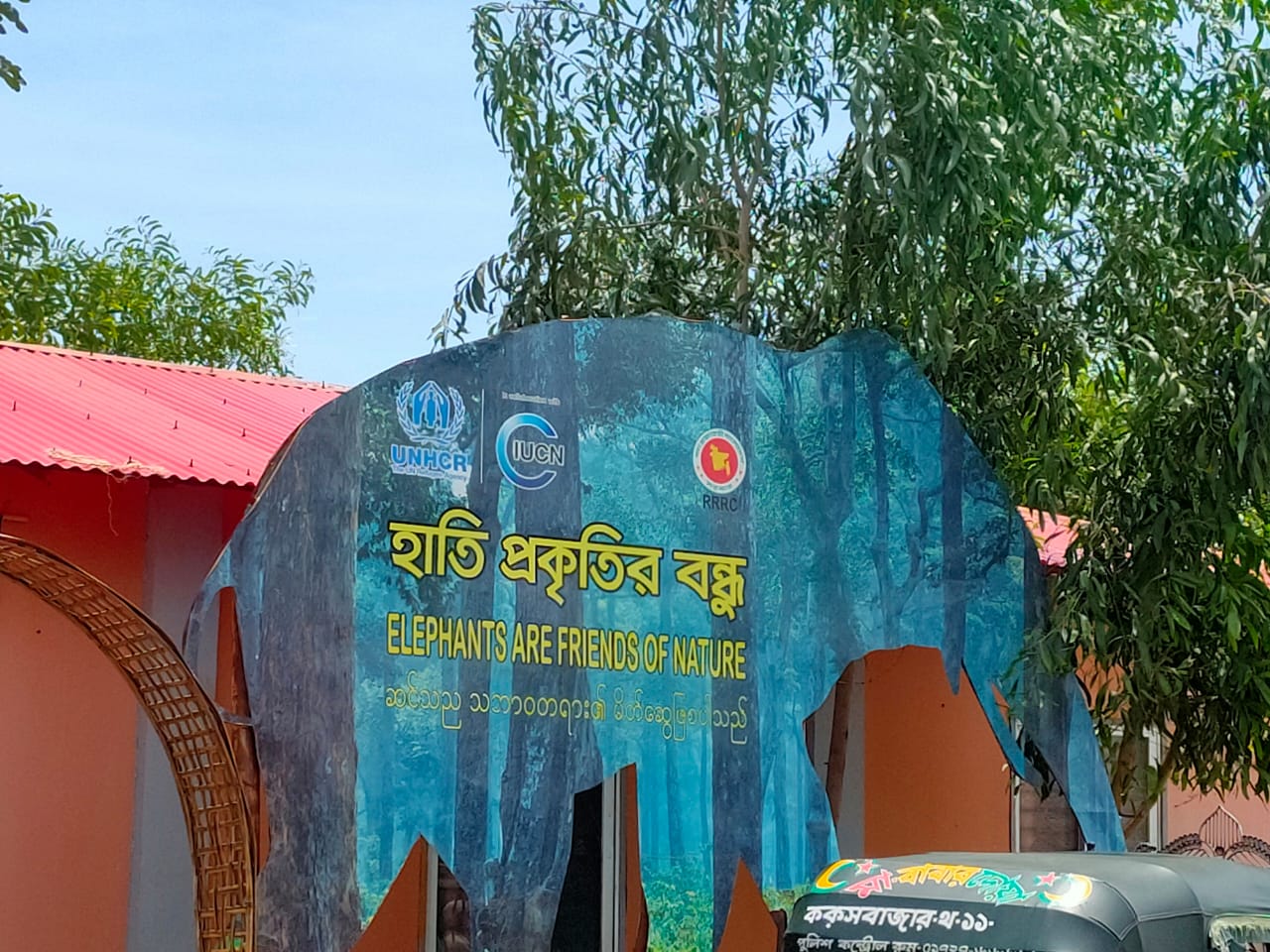
A sign reminding community members that “elephants are friends of nature.” Photo by Ro Yassin Abdumonab.
When they first came here in 2017, Abdurozok saw a considerable number of elephants. But now, elephant sightings have reduced in and around the camps.
“This place belongs to elephants. There were many elephants before. Last year we saw elephants every month but this year their visits have lessened. We only saw them twice during the winter season,” he says, “When we first came here, there were forests around us but now they’re gone.”
According to a 2019 estimate by IUCN, there are about 268 elephants in Bangladesh, and 35-45 of them live around the Rohingya refugee camps. Food and Agriculture Organization (FAO) Bangladesh officials told me that approximately 40-42 elephants are confined in the forests of Ukhiya and Teknaf of Cox’s Bazar. The existing elephant population is critically endangered, facing an acute scarcity of food and water with the threat of further habitat loss and a shrunken foraging area due to human encroachment and indiscriminate resource collection. Rajib Mahamud, Senior Forestry Specialist at FAO Bangladesh, said, “The location of the refugee camp blocked the elephants’ corridor. Several attempts by the elephants to cross through the camp caused conflict. These amazing creatures face a battle of survival because of a number of threats, including habitat loss, food scarcity, and conflict with humans. We are doing what we can to help the elephants. We are giving some of their forest back to them. It’s their home as well.”
Raquibul Amin, Bangladesh representative for the IUCN, tells me that due to the shrinking forest area and a blocked migration path, the elephants are in veritable danger, since being confined to a small area could cause a shortage of food as well as conflicts. Elephant-human conflicts arise because of the blocked migration path, which the elephants have been using for centuries. The migration pattern is embedded into their psyche, and so, they are battered by confusion when they find overpowering hurdles like sprawling camp areas on their route.
The elephants have been using the route — it traverses where the Kutapalong Refugee camp now stands — to travel between Bangladesh and Myanmar in search of food and shelter for centuries. In a statement, Ehsanul Haque, Assistant Environment Officer from UNHCR Bangladesh, says, “Before the refugee influx, two out of three migratory corridors of the elephants were blocked, as found by an IUCN study in 2016. Later, many refugee camps were established in 2017 over the only corridor left open. So far, IUCN-UNHCR intervention in partnership with the refugees and host community has handled 106 incidents of ‘Human-Elephant Contacts’ since 22 February 2018.”
Aside from blocked migratory routes, the loss of vegetation has also brought a cloud of tension over Cox’s Bazar. The latest finding reveals that 8,000 acres of forest area have been razed to make way for the settlements accommodating a large number of refugees since the mass exodus in August 2017. A team of forest ministry estimated the environmental loss to the tune of 24.20 billion Bangaldeshi takas ($285 million). A 2018 UN report finds that the refugee population has had to rely on fuelwood from surrounding forests for cooking and on trees for building their shelters, which caused an intense depletion of vegetation cover from the hills.
Ramzan Ali, a 46-year-old man who used to work as a woodcutter to sell logs to other refugees to support his family, says, “When I first came in this camp, there were forests around me; so I had to cut trees to build shelter and to use them as fuelwood. My neighbors also had to cut trees for the same reasons. We always used them to cook because we were not provided any gas cylinder at that time.”
A Small Ray of Hope
The situation has now changed, however. There are new policies on the table that encourage using LPG (liquified petroleum gas) as an alternative to fuelwood, since production of fuelwood gives rise to deforestation. Ehsanul Haque of UNHCR says that the demand for fuelwood within the refugee community has been reduced 80 percent. If that trend continues, he says, the natural habitat of tropical forest ecosystem will regenerate soon, and the refugees’ need to go to the forest to collect fuelwood — and the subsequent exposure to wildlife — will also be reduced.
Since 2018, a total of 1,135,735 LPG refills have been distributed among the refugee population. A recent study confirmed that after the LPG distribution, the rate of deforestation has come within sustainable forestry rates and the rate of firewood demand has also plummeted to “pre-influx levels.”
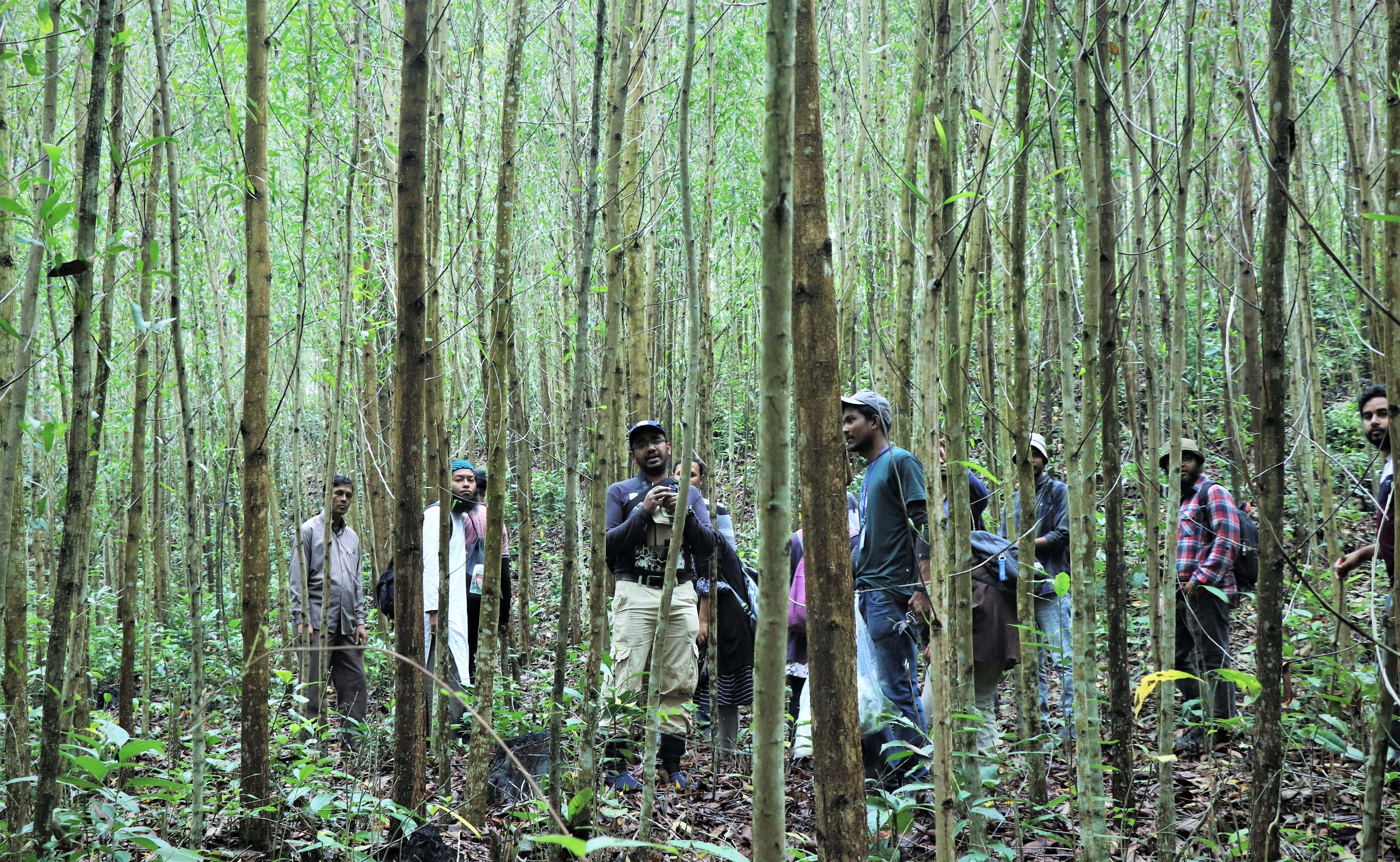
A field survey in forest areas as part of the floral diversity assessment plan. Photo: MH Kawsar Rudro, FAO.
In a statement, officials from FAO Bangladesh told me that they have launched SAFE Plus — a joint effort among FAO, the International Organization for Migration (IOM), and the World Food Program (WFP) that addresses environmental degradation through distribution of liquefied petroleum gas (LPG) and stoves, reforestation, and improved livelihood opportunities. FAO leads the reforestation segment and is currently working with the Forest Department to restore 2,000 hectares of forest. So far, 672 hectares have been restored. The provision of LPG cooking facilities and fuel to almost every household in the camp, along with 35,000 people from the host community, has greatly reduced the pressure on forests, they said.
Meanwhile, FAO has developed technical guidelines to restore wildlife habitats, with a focus on elephants, and will pilot the restoration work on 20 hectares of forest in Cox’s Bazar later this year. As part of a conservation strategy, FAO – in collaboration with the IUCN and the Forest Department – is assessing the area’s floral diversity (the diversity of naturally occurring indigenous or native plants). The work will identify “indicator species” to monitor the long-term health of the forests, as well as potential “mother trees” that can be harvested for high-quality seeds to reforest the areas.
Robert D. Simpson, the FAO representative in Bangladesh, says, “We are deploying FAO’s global expertise and working with our partners so that these elephants do not disappear altogether from the forests of Cox’s Bazar. Our reforestation work in the area will be crucial to the elephants’ long-term survival. By taking these measures, we will not only be protecting humans from elephants but also elephants from humans.”
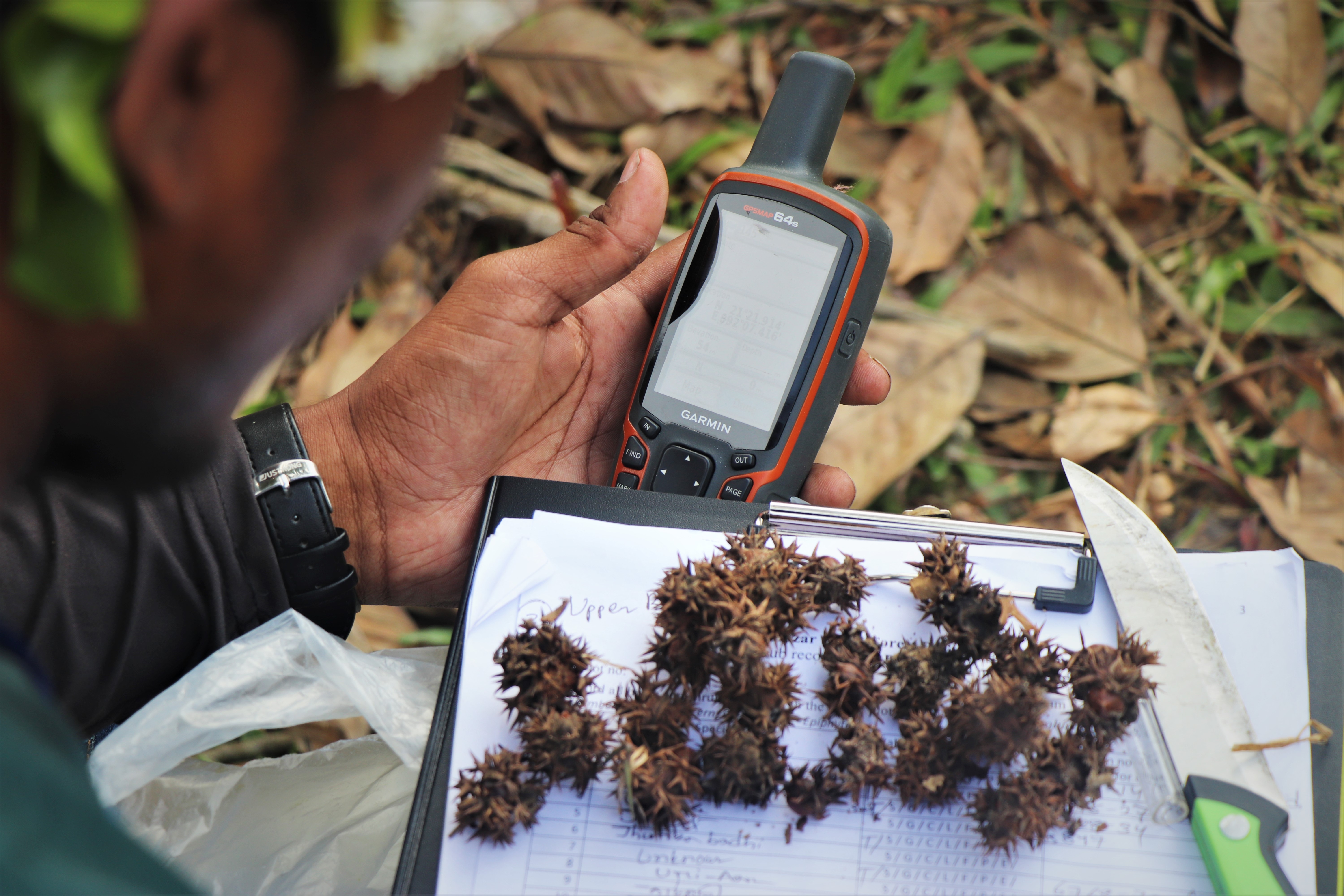
Specimens are gathered during a field survey in forest areas as part of the floral diversity assessment plan. Photo: MH Kawsar Rudro, FAO.
The Troubled History of the Rohingya People
Muslim settlers came to Arakan as early as the 1430s. In 1784, the state was conquered by the Burmese Empire, and subsequently, from 1824 until 1948, the British ruled Burma as part of British India. In that period, many Muslims from the Indian subcontinent (especially Bengal) entered Burma as migrant workers. At the time, it was considered internal movement since Burma did not have the status of a separate country. Thus Muslims’ roots in Burma can be traced back centuries, but after Myanmar gained independence from Britain in 1948, it refused to accept the Muslim population as its citizens. In 1982, Myanmar officially stripped the Rohingya people of citizenship, which led to rising discrimination in jobs, healthcare, and education and to restrictions on their movement outside Rakhine state. Because of the citizenship law, the Rohingyas are considered stateless; Myanmar officially refuses to even use te name “Rohingya,” preferring to call them “Bangladeshi immigrants.” Myanmar recognizes 135 ethnic groups within the country, but the Rohingyas are excluded from the recognition.
In 1962, Myanmar launched Operation King Dragon, and unleashed its military forces upon the Rohingya people. Accusations of human rights abuses like rape, destruction of property, and mass incarcerations rose, and the Rohingya people started pouring across the border into Bangladesh. A similar campaign followed in 1991, named Operation Clean and Beautiful Nation, which drove more Rohingya people out of the country. In 2017, theArakan Rohingya Salvation Army (ARSA), a Rohingya militant group, launched attacks on more than 30 police posts, and the state retaliated by propelling retributive measure that spurred a mass flight on Rohingyas in August 2017. Persecuted, they desperately fled across the border and most of them settled in the closest safe spot — Bangladesh’s Cox’s Bazar. They brought with them stories of horror and genocide. On May 24 this year, Myanmar submitted a required report to the International Court of Justice on the persecution of the Rohingya people. Although the report has been deemed “an important milestone,” the discussion around safe repatriation of the Rohingya people and easing the burden on Bangladesh seems lukewarm, as the refugees remain in constant and justified fear of persecution after going back.
The amputated hills and forests of Cox’s Bazar stand as testaments to the fact that it is not only humans who bear the brunt of such violence. The environment does, too. Even though the future of the elephants in Cox’s Bazar hangs in the balance due to the disruption of their migratory movements, it is worth noticing that concerted efforts by the government and international bodies have facilitated an atmosphere of coexistence. For the Rohingya refugees and the elephants, this rocky life of coexistence treads forward as it has since the exodus.
With reforestation and other significant conservation plans — like radio collaring to understand elephant behavior in the wild and their response to the new situation — underway, a ray of hope flickers on the horizon, although more breakthroughs in settling the environmental tension are yet to emerge.
“Across the world, the socioeconomic needs of human populations must be balanced with the sound management of wildlife species and their habitats. It is incredibly important to do all that we can to protect the remaining elephants in Cox’s Bazar, which sadly are very few,” says Robert Simpson of the FAO.
Shah Tazrian Ashrafi is a freelance journalist based in Bangladesh.
Ro Yassin Abdumonab also contributed to the report as an interpreter and fixer.













